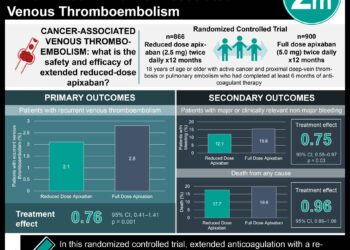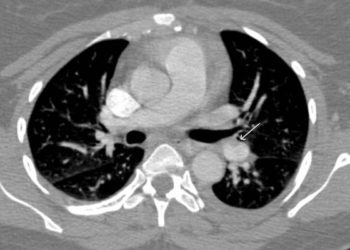Age-adjusted D-dimer levels may rule out pulmonary embolism [ADJUST-PE trial]
Image: PD
1. Baseline D-dimer levels increase with age, increasing the test false positive rate without age adjustment.
2. Age-adjusted cutoffs increase the rule-out efficacy of the D-dimer screen.
Evidence Rating Level: 2 (Good)
Study Rundown: D-dimer levels are often used to rule out pulmonary embolism (PE). Negative D-dimer levels, less that 500µg/L, have up to a 99% sensitivity for pulmonary embolic events. Retrospective studies have shown that an age-adjusted D-dimer cutoff of 10 times the patient’s age in patients older than 50 years maintains the same level of sensitivity of detecting PE while decreasing the false positive rate. This study, the ADJUST-PE trial, further validated these findings in a prospective trial. It was found that using an age-adjusted D-dimer cutoff in conjunction with probability criteria decreased the rate of false positive screenings in elderly patients.
Due to the nature of the study and multiple centers participating, a standard D-dimer assay was not implemented. However, all of the assays used had similar reliability. Additionally, there was no control group which with to compare the experimental results. Despite these limitations, the ADJUST-PE trial indicates the potential of implementing age-adjusted cutoffs and thus has implications for improved quality of care.
Click to read the study, published today in JAMA
Relevant Reading: Diagnostic accuracy of conventional or age adjusted D-dimer cut-off values in older patients with suspected venous thromboembolism
In-Depth [prospective cohort]: This study evaluated the efficacy of using an adjusted D-dimer cutoff as a rule-out test for PE. Patients were chosen from the Netherlands, Belgium, France, and Switzerland. A total of 3324 patients were included in the final analysis. Patients with high suspicion of PE or elevated risk based on diagnostic criteria, Wells or Geneva score, were sent directly for CTPA, the gold standard for diagnosis. Patients with low probability of PE were worked-up with only D-dimer levels. Patients with D-dimer levels below 10 times their age were not treated further. All patients were followed-up at 3 months and surveyed for any subsequent thromboembolic events. Of the 817 patients with D-dimer levels less than 500 µg/L, 0.1% (CI95%, 0.0-0.7%) had an undetected thromboembolism. In the 337 patients with D-dimer levels between 500 µg/L and 10 times their age, there was a failure rate of 0.3% (CI95%, 0.1%-0.7%). Finally, of the 200 participants older than 75 years with a low clinical suspicion and negative age-adjusted D-dimer tests, no patients had confirmed venous thromboembolism at follow-up.
More from this author: Warfarin beneficial in chronic kidney patients with atrial fibrillation, Radiofrequency catheter ablation effective as first-line therapy for atrial fibrillation [RAAFT-2 trial], Vitamin E associated with slower functional decline in Alzheimer disease [TEAM-AD Trial], PET scans accurately identify amyloid deposition following traumatic brain injury, Bystander CPR positively associated with cardiac arrest survival
©2012-2014 2minutemedicine.com. All rights reserved. No works may be reproduced without expressed written consent from 2minutemedicine.com. Disclaimer: We present factual information directly from peer reviewed medical journals. No post should be construed as medical advice and is not intended as such by the authors, editors, staff or by 2minutemedicine.com. PLEASE SEE A HEALTHCARE PROVIDER IN YOUR AREA IF YOU SEEK MEDICAL ADVICE OF ANY SORT.









